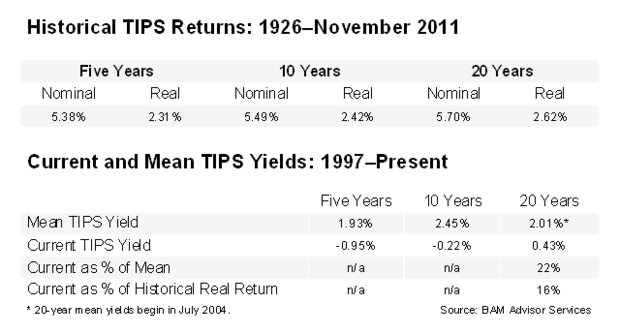TIPS update for January 2012
On a monthly basis, my BAM Advisor Services colleague Dan Rush and I update the tables below to help you make decisions on purchasing Treasury inflation-protected securities. The data is as of January 17. The first table provides the historical data on the real return of "nominal" Treasury bonds from 1926 through November. The second table shows the current and mean TIPS yields.
Not much has changed from our December update. Rates have fallen slightly, but the overall strategy has not changed. The 10-year and 20-year nominal Treasury yields decreased and are currently yielding 1.85 percent and 2.54 percent, respectively. Last month, they were 1.91 percent and 2.57 percent, respectively. Break-even inflation rates increased slightly last month. The 10-year and 20-year break-even rates are now about 2.08 percent and 2.11 percent.
The fourth-quarter inflation estimate from the Philadelphia Federal Reserve released in November was 2.5 percent over the next 10 years. The negative risk premium for unexpected inflation (the difference between the headline CPI estimate from the Philadelphia Fed forecasters and the break-even rate between nominal Treasuries and TIPS) on 10-year nominals slightly decreased over the last month from -0.49 percent to -0.42 percent over the last month. With the risk premium for unexpected inflation continuing to be negative, TIPS remain our preference over nominal Treasuries of the same maturity.
The current yield on the five-year nominal Treasury is 0.78 percent. With the Philadelphia Fed's fourth quarter five-year inflation forecast at 2.4 percent, the expected real return is now -1.62 percent (0.78% - 2.40%). The market break-even rate between Treasuries and TIPS is 1.73 percent, which means a -0.67 percent risk premium when comparing it to the Philadelphia Fed estimate (1.73% - 2.40%). This would mean the five-year TIPS have more attractive yields relative to the nominal five-year Treasury and makes them still the preferred choice.
In the past couple months, we have mentioned one alternative to purchasing five-year TIPS: five-year CDs. TIPS and Treasury yields are now even further below historical averages, while CD yields remain relatively unchanged. Investors who have greater capacity to accept the risk of unexpected inflation for five years may want to consider five-year CDs. Five-year CDs are yielding 2.00 percent, which makes their break-even inflation rate relative to five-year TIPS 2.95 percent (2.00% - -0.95%), or roughly 1.22 percent over comparable nominal Treasuries. Investors who choose five-year CDs need to understand they're not as protected as TIPS buyers for higher unexpected inflation. They're also giving up the term premium of the TIPS curve by electing to stay shorter, as opposed to purchasing TIPS with maturities of greater than five years.
Over the past month, TIPS had a slightly stronger performance relative to nominal Treasuries. Ten-year TIPS yields fell by 0.12 percent, while 10-year Treasury yields fell by 0.06 percent. Additionally, the 20-year TIPS rallied 0.06 percent, while Treasuries rallied only 0.04 percent.
Although TIPS yields were lower across five-, 10- and 20-year maturities, the TIPS curve steepened slightly over the past month. The five and 10-year maturities decreased about 0.12 percent each, while the 20-year only decreased around 0.06 percent. Last month, extending from the five-year to 10-year meant picking up 0.73 percent. Extending another five years gives you around 0.10 percent per year, and beyond that around 0.07 percent per year. Currently, to get positive real yields, investors would have to extend to the 2025 maturity (0.12 percent). With real TIPS yields even further below their historic averages, those investors disinclined to subject their portfolios to additional price risk might find it more prudent to limit maturities to about 10 years.
While TIPS yields don't look attractive relative to historical averages, you can't buy yesterday's yields, only today's. And since our crystal balls are always cloudy, we can't know if the current yield on longer-term TIPS will look like good or bad 10 years or more in the future.
As always, one last point to remember is that one of the advantages of TIPS over nominal bonds is that you can take maturity risk with TIPS and earn the term premium without taking inflation risk. Thus, while longer-term TIPS have more interim price risk -- which for some investors could be too much volatility to stomach -- there's no risk of loss if you hold to maturity.
Summarizing, it still seems prudent to limit maturities to about 10 years or so, since absolute yields are well below levels that would make longer-term TIPS a compelling buy regardless of the shape of the yield curve. If real rates rise well above the historical averages, you should consider locking in the higher yields for as long as possible, regardless of the shape of the yield curve. Higher TIPS yields would provide the added benefit of allowing you to lower your equity allocation, thereby reducing the risk of the overall portfolio without lowering expected returns.
